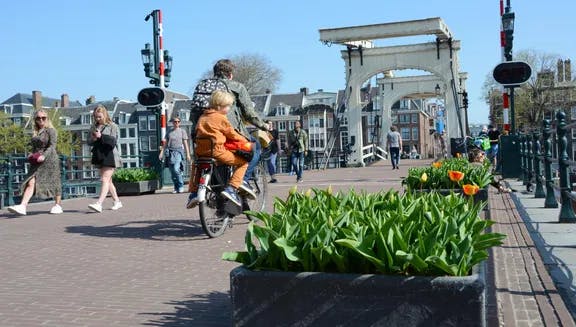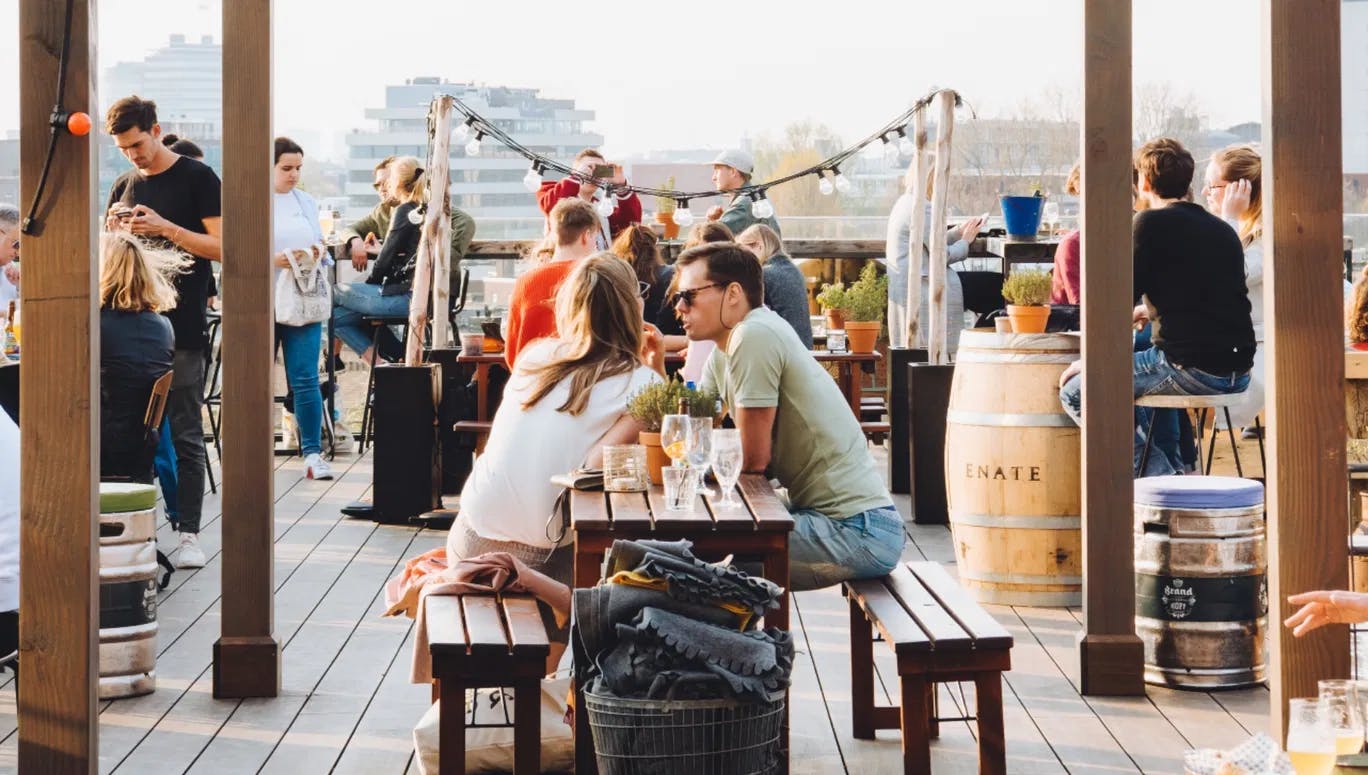
From personal experience: What is it like to relocate to Amsterdam?
30 September 2025

Wind in your hair, and a new city ahead of you: there’s no better way to explore Dutch cities than by bike. From stumbling across places you never knew existed, to effortlessly moving through busy streets, you’ll be amazed at how much you can uncover. If you haven’t cycled much, take the time to understand the rules of the road before heading out into rush-hour traffic. Once you’ve got the hang of it, you’ll find it’s as easy as…well, riding a bike.
There are plenty of options to buy or rent your trusty steed. It’s commonplace to buy a second-hand bike from one of the bike shops that pepper city streets, or find a good bargain at flea markets like Amsterdam’s Waterlooplein. There’s always online marketplaces like Marktplaats if you know what style or model you’re after, too. If you’d rather rent, the best option for locals is to pick up an OV-fiets from a rental location near you. In the long-term, subscription companies like Swapfiets, which loans bikes from €16.58 per month, are a more affordable option.
In Amsterdam, GVB’s extensive, safe and clean network connects neighbourhoods with the Amsterdam area, and includes trains, trams, metro, buses, and even ferries. Most locals travel using an OV-chipkaart, which you can use on trams, buses and the metro network, or you can simply check-in and out directly with your debit or credit card thanks to the new OVpay system. Explore the most affordable ticket options that are most suited to the way you travel (discounted season tickets are your best bet if you travel between cities often).
In cities like Amsterdam, smaller local supermarkets are more commonplace than larger hypermarkets you find throughout Europe. For that reason, people often shop throughout the week rather than in chunky weekly or monthly hauls – but if that’s more your style, online ordering from large supermarkets such as Albert Heijn, Jumbo, Dirk, or the app-only supermarket Picnic is always an option. There’s a great range of supermarkets, and plenty of sustainably-conscious ones popping up, too. Amsterdam-grown start-up Crisp offers local and seasonal produce from over 900 small-scale suppliers.
Most supermarkets also house a Statiegeld machine, which gobbles up certain recyclable bottles and cans in exchange for a monetary voucher – which you can then use to save money on your shop. Oh, and be aware that Dutch supermarkets charge for plastic bags too – so keep a stash by the door or even better, skip the plastic and bring your own bag.
All cards on the table: you can pretty much count on being drenched by an unexpected downpour on your morning commute at least once. But it’s far from doom and gloom. Once you get the essential rain gear (like transparent hoods, pull-over trousers and shoe covers) you’ll be able to get out there whatever the weather. After all, as the saying goes ‘jij bent niet van suiker gemaakt’ (‘you aren’t made of sugar’).
So, when it’s time to shop for rain gear and beyond in Amsterdam, where do you go? The city has plenty of great places to shop – from the boutiques nestled in the Negen Straatjes, to the second-hand treasure troves of Kringloops and flea markets. Amsterdam’s shopping scene has evolved to take on an increasingly environmentally-conscious focus, and there’s now a range of options for sustainable shops – so you can rest assured your new favourite look has been made with mindful consumption at heart.
The Netherlands is ahead in cashless transactions, and most people – and almost all establishments – prefer card payments. Debit cards are widely accepted, and as of this year, debit cards issued will mostly be Mastercard and Visa rather than the most common Maestro – which was less accepted in countries outside of the Netherlands. You’ll know you’re a real Dutchie when you receive your first Tikkie: a popular online payment app that allows you to forward payment requests to people via WhatsApp, or pay through a QR code.
The Dutch pride themselves on a healthy work-life balance. So, how do people enjoy spending their free time? From rowing and taking cooking classes to playing padel, there’s huge diversity when it comes to socialising the Dutch way. And a lot of it often takes place around a good meal. In the Netherlands, most people eat relatively early on at around 6:30 pm. Most restaurants will be full from this time too, with kitchens often closing around 10:00 pm. Service charges are very rarely added on to bills when it comes to settling up – and tipping is not mandatory either. A 10% tip if you’ve experienced good service is standard.
Want a nightcap? In Amsterdam, bars often stay open on weekend evenings until 02:00 or 03:00, at which point clubs will be in full swing. There are some fantastic live music venues in Amsterdam, with spots like Paradiso and Melkweg offering an eclectic program. Check out the ever-changing monthly calendar so you don’t miss out on the city’s world-class cultural agenda.
So you get the whole statiegeld deposit scheme thing – but how should you sort your household waste? Well, that depends on your neighbourhood. In the Amsterdam area, it’s most common to sort your household waste by type (refuse – restafval – textiles, glass and cardboard/paper) and dispose of it into the underground designated containers outside on your street. But make sure to check with your local municipality (or Gemeente), as slightly different rules apply depending on where you live. On most websites, you can simply enter your address to check.
Ready to throw away that broken lampshade or an old mattress? The rules are slightly different for bulky waste. In most neighbourhoods in Amsterdam, you can place your bulky waste on the special paving stones marked grof vuil on certain days of the week – but again, check the rules for your address. And remember, one person’s trash is another’s treasure: things that could go to a new loving home can always be donated to a second-hand shop.
You’ll soon find that in the Amsterdam area in particular, a lot of people speak English as a second language. Many global companies are internationally-minded too, and adopt English in offices. But while it may be tempting to stick to English, you’ll find that understanding and speaking Dutch opens a whole host of opportunities: from new friends, to a better cultural understanding of your new home.
With free lessons offered by the City of Amsterdam, private tutoring, and language schools all designed to help newcomers kickstart their Dutch abilities, there are plenty of ways to learn Dutch in the Amsterdam area. You’ll spreek Nederlands in no time.